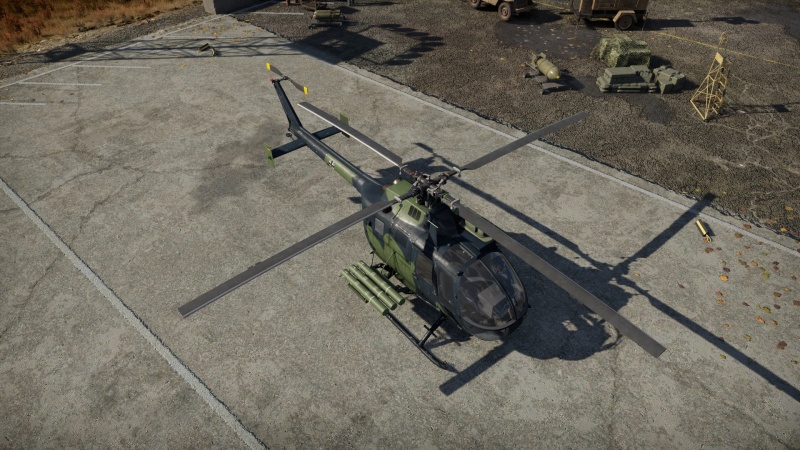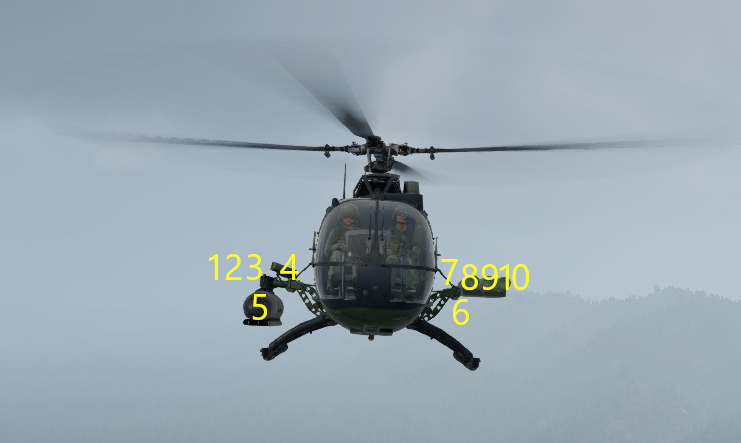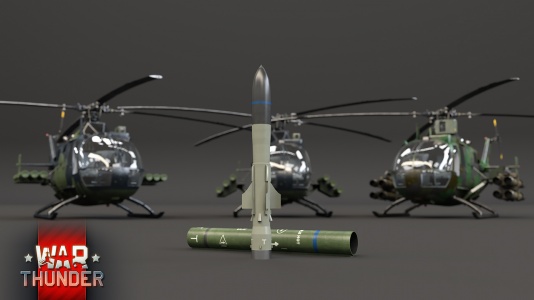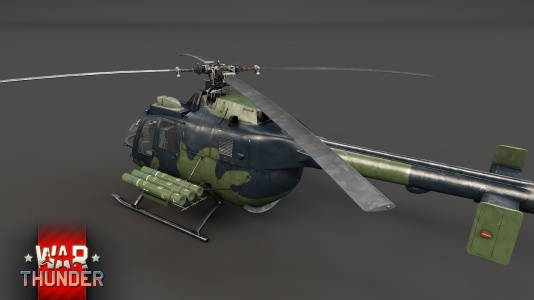BO 105 PAH-1
| This page is about the German utility helicopter BO 105 PAH-1. For other versions, see BO 105 (Family). |
Contents
Description
BO 105 PAH-1 (Panzerabwehrhubschrauber: "anti-tank helicopter") was an attack version of the BO 105M multi-purpose helicopter, developed by MBB. In this configuration, the helicopter was able to carry up to six HOT missiles. Between 1979 and 1984, a total of 212 BO 105 PAH-1 helicopters were delivered to the West German Army. However, the helicopter's inability to perform combat missions at night, as well as its low survivability and self-defence capabilities, eventually led to its replacement by the Eurocopter Tiger. The last BO 105 helicopters were retired from service by the German army in 2016.
Introduced in Update 1.83 "Masters of the Sea", the BO 105 PAH-1 is a light, fast, manoeuvrable, and small helicopter capable of delivering quick and swift attacks as well as quickly withdrawing from ground fire. However, for its lightness, it has to pay with the absence of any armour. Although small, its arsenal includes 12.7 mm machine guns and a set of HOT anti-tank guided missiles, and for protection against heat-seeking missiles, it can be equipped with flares.
General info
Flight performance
| Characteristics | Max Speed (km/h at 0 m - at sea level) |
Max altitude (metres) | |
|---|---|---|---|
| AB | RB | ||
| Stock | 215 | 197 | |
| Upgraded | 257 | 242 | |
Survivability and armour
The BO 105 PAH-1 does not have any armour plates. The three self-sealing fuel tanks are located under the floor on the cabin of the helicopter. Both engines are located next to each other, a single hit with an air to air missile or a high penetrating shot will be able to destroy both engines.
The BO 105 PAH-1 has one gunner and one pilot they are located next to each other. If the gunner is knocked out, the none of the weapon systems can be fired. Additionally, BO 105 PAH-1, is one of the most agile helicopters in game since it is not weighed down by heavy armour plating which results in excellent agility.
Modifications and economy
Armaments
Suspended armament
The BO 105 PAH-1 can be outfitted with the following ordnance:
| 1 | 2 | 3 | 4 | 5 | 6 | 7 | 8 | 9 | 10 | ||
|---|---|---|---|---|---|---|---|---|---|---|---|
| 12.7 mm FN M3P machine guns (250 rpg) | 1*† | 1*† | |||||||||
| 12.7 mm FN M3P machine guns (400 rpg) | 1† | 1† | |||||||||
| FFAR Mighty Mouse rockets | 3*† | 3*† | |||||||||
| HOT-1 missiles | 1† | 1† | 1† | 1† | 1† | 1† | |||||
| Countermeasures | 30† | 30† | |||||||||
| * FFAR rockets and 250 rpg machine guns can only be equipped together † HOT-1 missiles cannot be equipped in conjunction with machine guns, rockets, or countermeasures | |||||||||||
| Default weapon presets | |
|---|---|
| |
Usage in battles
The BO 105 family can be used at any time of the battle. You can try to quick cap in an inexpensive scout vehicle and gain enough spawn points for the loadout with 6 ATGM and then pick off unsuspecting tanks.
Positioning: Stay at maximum range (3.5 to 3.9 km) to be able to react to incoming fire. This means you need to cancel the forward speed. Do this by pulling back sharply on the cyclic (S key) until your nose points upwards, then activate the hover mode. Use the rudder to orient the nose towards the enemy. This step is important and most pilots fail to stay at range and get shot down by small calibre, main gun or SPAAG fire. Check the battle rating and stay low if you face SAM, otherwise you can safely gain altitude to prevent targets from driving behind cover.
Target selection: From the moment you take off from the helipad, scan the enemy spawn points first, as previously knocked out enemies are likely to respawn in a SPAA. Your primary targets should be anti air vehicles, followed by lightly armoured vehicles, as they present almost guaranteed single-shot knock-outs. MBT can easily be engaged from any angle if you can aim the missile precisely. Consider aiming at closest vehicles first, as this reduces missile flight time and increases your hits per minute.
If you get shot by ground vehicles, you should switch the target by going to the third person perspective and trying to locate the threat. Then point the helicopter nose to the target in order to be able to fire the missile
Aiming: Aiming is easy in hover mode, however, the BO has a very small launch window, due to the SACLOS missiles, similar to a caged infrared seeker. If your altitude is too high, you might need to quickly lower the nose to be able to fire the missile. If you lose the lock when the nose is brought back up by the instructor, you should descend or go back to pilots view and orient the nose towards the enemy. Unless a tank presents you his front, you should aim for the turret. Frontally, aim for the drivers hatch.
Evasion:
- Avoiding incoming fire: Key to survival is staying at range in order to increase the available reaction time. If you get closer than 2km, turn around and you will dramatically increase survivability. To avoid incoming fire you need to be able to see it, i.e. you should not zoom fully into the target from the very first second from the launch. Since the missile travels 12-16 seconds, you can safely stay zoomed out for 10 seconds and you will be able to see incoming SPAAG fire. Enemy SPAAG will aim for the projected point where you will be after the flight time of the bullet so your goal is to change your flight path constantly but not predictable. You could fly a roll by keeping A or D pressed or you could fly a box shaped pattern. The missile will still track during such a manoeuvre and only shortly before the impact you need to be in an upright position for a good aim.
- Avoiding enemy planes: Enemy planes will usually detect you visually. You can be seen and heard from far away. You can open your cockpit doors with a preferred keybind to hear incoming missiles or aircraft in gunner mode. If you detect an enemy plane, you should go low (below the tree line, into a valley) and you should try to hover. A helicopter hovering below the treeline in a forest is nearly invisible. On a map without trees you can try to take cover behind buildings taking advantage of the impressive manoeuvrability of the BO 105, but you need to be very close to the building and very close to the ground. The hangar on the helipad is very well suited for this, but skilled pilots will notice that and try to attack directly from above, in which case you should try to fly under the aircraft in a Split S maneuver, forcing the enemy pilot to go around or strike the ground.
Pros and cons
Pros:
- Excellent manoeuvrability
- Highly agile, able to perform rolls that can evade planes, incoming ground or air to air missiles and long range APFSDS shots
- ATGM can be effectively used against tanks
Cons:
- Small guidance window for missile launches and tracking
- Cannot really defend itself against enemy helicopters and/or enemy planes
- No armour protection, a well placed hit will knock it out
- No machine guns or cannons mounted directly on the aircraft, unlike Ka-52, AH-64D
- Machine guns can only be installed on the wing mount which reduces the ATGM loadout options
History
The BO 105 was a helicopter developed in Germany in the 1960's and 1970's for both civil and military markets. The BO 105 PAH-1 (PAH standing for Panzerabwehrhubschrauber; tank-defense helicopter) is a military variant of the BO 105 helicopter. It is in service with the German Army.
The German Army made the decision to procure a specialist anti-tank version of the BO 105 in 1975, which could carry up to six Euromissile HOT missiles. 212 were delivered in total between 1979 and 1984, and they were designated as the BO 105 PAH-1.
The BO 105 PAH-1 had been developed as a temporary, stop-gap measure until a more capable anti-tank helicopter entered service. The German Army found its lack of self-protection capabilities and lack of night combat capability to be great issues.
As such, the Eurocopter Tiger was developed and entered service in the early 2000's. When the Eurocopter Tiger entered service, some BO 105 PAH-1s were retired while others were disarmed and modified to the VBH standard (Verbindungshubschrauber; liaison chopper) transport and surveillance helicopter. The converted PAH-1s replaced the BO 105M in that role.
The BO 105 PAH-1 featured a completely hingeless rotor arrangement, an uncommon feature for helicopters; the main rotor had four blades and the tail rotor had two. The power came from two Allison 250-C20B engines, rated at 420 SHP each. Internal fuel provisions were for 570 litres, but external tanks could be carried to increase the range. The BO 105 series was known for their reliability, almost never breaking down. They were designed so that if one engine was lost the helicopter could continue to fly, albeit with less speed and range. The BO-105 PAH-1 was flown by a crew of two.
Media
- Skins
- Images
- Videos
See also
Links to the articles on the War Thunder Wiki that you think will be useful for the reader, for example:
- reference to the series of the helicopter;
- links to approximate analogues of other nations and research trees.
External links
| Messerschmitt-Bölkow-Blohm (MBB)* | |
|---|---|
| Utility | BO 105 CB-2 · BO 105 PAH-1 · BO 105 PAH-1A1 |
| Export | HKP9A · HKP9A (FC) |
| *This company is a conglomeration of several post-war aviation companies which focused on building helicopters. | |
| Germany helicopters | |
|---|---|
| Attack | |
| Hip | ◊Mi-8TB |
| Hind | ◊Mi-24P · ◄Mi-24P HFS 80 |
| Tiger | EC-665 Tiger UHT |
| Utility | |
| BO 105 | BO 105 CB-2 · BO 105 PAH-1 · BO 105 PAH-1A1 |
| Alouette | ◄SA 313B Alouette II |
| Huey | ◄UH-1D |








